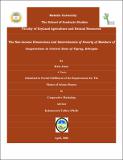| dc.description.abstract | Poverty has been and remains today a contested area. There is unanimous agreement
that it is a problem and that action is needed to address it. However, there is a
disagreement over what constitutes poverty, the unit of focus (individuals or households)
and the importance to be given to different dimensions of poverty. Disagreement about
what constitutes poverty is in turn closely linked to disagreement about its causes and the
weight to be given to these different causes. This, in turn, leads to disagreement about
how best to address it.
Likewise, in an attempt to fill the research gap observed in Ethiopia with the capability
perspective, the present study was carried out at Central Zone of Tigray National
Regional State with specific objectives of exploring the non-income dimensions and
determinants of poverty of members of cooperatives in the rural areas. In order to attain
this aim the study made use of the primary data collected by conducting formal
household survey from representative sample respondents through personal interview
using structured schedule. A two stage cluster sampling design was followed to select the
primary sampling units (PSU). In the first stage, the list of all multi-purpose primary
cooperatives from each selected woreda was used to identify that cooperative to be
included in the survey using systematic random sampling method. Subsequently, the list
of all multi-purpose primary cooperative members from each Tabia cooperative promotion office was used as a frame to select the sample households of members of
cooperative in the rural areas of central zone of Tigray.
The data collected from the survey on annual expenditure of households on consumption
and non-consumption items were analyzed and comparing the non-food expenditure
component calculated from the data available against the results of non-food expenditure
component deflated to 2008 for rural Tigray, 47 sample households (27%) were poor and
127 sample households (73%) were found to be non-poor.
The result of the logistic regression model revealed that among the 18 variables
considered in the model, 9 explanatory variables are found to be significant up to less
than 10% probability level. Accordingly, getting services from cooperatives (significant
at less than 1%), dependency ratio, number of livestock owned, health status of
household members, number of household assets owned by the household and body mass
index of household members greater than or equal to 18.5 (significant at less than 5%
level), and family size, ability of the household head to read and write and copping
mechanism of the household in times of emergency (significant at less then 10%) were
found out to have strong negative correlation with the households non-income poverty
status. | en_GB |


